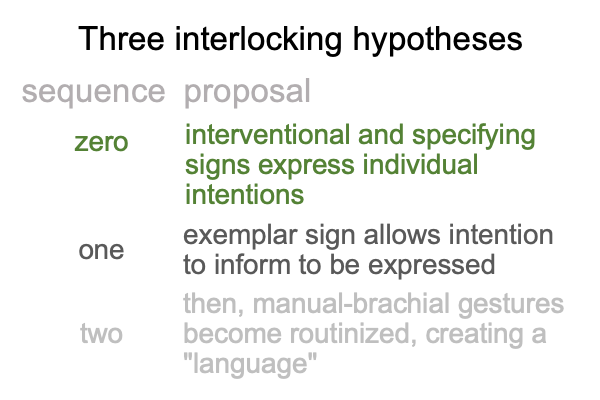0176 Once again, here is Tomasello’s adjustment to the scholastic interscope.
Is this the [substance] of Tomasello’s research?
The exemplar sign is foregrounded.

A hominin perception2b (SVe) stands for a judgment2c (SOe) in regards to a common conceptual ground3c operating on the potential of ‘mutual expectations’1c (SIe).
0177 Here is the original scholastic interscope for how humans think.
The exemplar sign is foregrounded.

A species expressa2b (SVe) stands for a species intelligibilis2c (SOe) in regards to what makes sense3c operating on the potential of ‘contextualizing the situation’1c (SIe).
0178 With these two signs in juxtaposition, consider the three processes that Tomasello identifies as basic to the evolution of hominin cooperation: informing, requesting and sharing.
All three processes associate to the exemplar sign.
0179 So, chapter five invites a question, asking, “What are the conditions where exercising the exemplar sign increases reproductive success?”
The answer must be cooperative activities that increase reproductive success.
That is the topic of the next book in this series.
0180 But, before I leave this examination, I would like to return to prior expositions of the three steps of hominin evolution (points 0097 and 0132).

0181 The adaptations of joint attention and mutual intentionality associate to step one in the origins of hominin communication.
0182 The zeroth period stretches from the last common ancestor to the start of the Pliocene, where the first bipedal apesappear in the fossil record. Bipedalism is an adaptation away from tropical forest and into mixed forest and savannah. In these new conditions, collaborative foraging pays off. As soon as cooperation in foraging activities increases reproductive success, the niche of sociogenesis opens up. The team is the first social circle to benefit from joint attention and mutual intentionality.
The last common ancestor dates to around 7Myr (million of years ago). The earliest bipedal apes appear around 4.2Myr. So, I give an additional 0.7 million years for these walking creatures to start to realize that collaboration pays off.
0183 The first period nominally starts at 3.5Myr. During the next 1.7 million years, natural selection explores the adaptive spaces generated by joint attention. This includes the space for the evolution of hand talk within collaborating teams. The Homo genus appears in the fossil record around 1.8Myr. The expansion of the hominin neocortex is testimony to an increasing number of successful teams. For each team tradition that increases reproductive success, subsequent adaptations routinize that success. More common grounds and styles of mutual intentionality are programmed into an expanding brain. Each hominin team becomes better and better at what it does.
The second period begins around 0.8Myr. Homo erectus has already migrated out of Africa and into Eurasia. The domestication of fire ensues. This is the beginning of the next phase, where hominin hand talk becomes fully linguistic.
0184 Even though Tomasello proposes a significantly different timeline, the following list expresses this examiner’s opinion of what Tomasello’s timeline should be.

The discrepancy between Tomasello’s proposed timeline and this examiner’s list needs to be accounted for.
0185 This commentary is not a substitute for Tomasello’s text. It is a complement to his explorations. Tomasello is an excellent, well-organized writer. My examination may be scattered and disorganized, but it adds value by re-articulating his arguments in a semiotic framework.
The term, “semiotics”, does not appear in the index of Tomasello’s book. But, that is not a drawback. That is an opportunity for me, a semiotician, to demonstrate a deep correspondence between Tomasello’s arc of inquiry and Razie Mah’s masterwork, The Human Niche (available at smashwords and other e-book venues).
0186 Sociogenesis is the potential of triadic relations.
